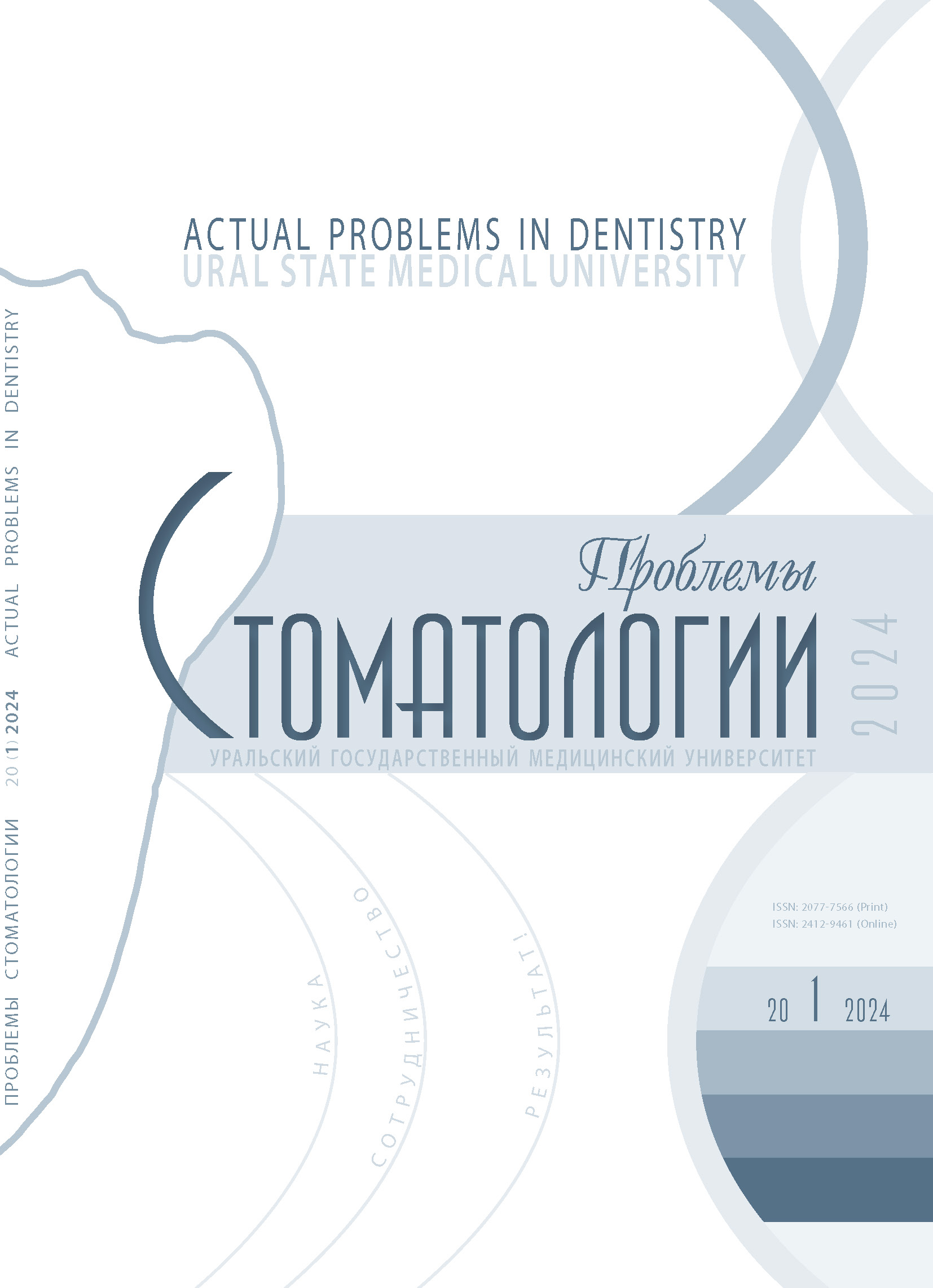Stavropol, Stavropol, Russian Federation
Stavropol, Russian Federation
Penza, Penza, Russian Federation
Stavropol, Stavropol, Russian Federation
Vladikavkaz, Vladikavkaz, Russian Federation
Moscow, Moscow, Russian Federation
Grozny, Grozny, Russian Federation
UDC 616.31
Today, an interdisciplinary approach to solving the problems of implantology is the key to the effective use of intraosseous dental implants. The possibilities of preclinical modeling of the state of bone tissue and the future implantation and prosthetic beds allow us to assess the possible risks of implant rejection, calculate the necessary tightening force of screws in implantation systems and predict the points of application and stress distribution of dental implantation materials, taking into account the latter, the desire to improve modeling will allow us to obtain a predictable treatment result. In this study, a mathematical model of the stress distribution on the walls of a conical implant was investigated, taking into account the physical properties of the VT 6 material, an assessment was carried out using the example of computer models with embedded alloy characteristics, and the Mises distribution indicators were calculated. It is worth noting that the VT6 alloy has a very high quality, thanks to alloying additives. This titanium alloy includes aluminum, which has a beneficial effect on the strength of implants, as well as vanadium, which can increase the strength of the metal and make it more ductile. Titanium alloy VT6 has characteristics that are comparable to those of stainless steel, due to which it is considered as an inert metal for use in the oral cavity. The novelty of the proposed model lies in the fact that it operates with the minimum possible set of input data and provides adequate estimates of the most significant output parameters that are necessary for practical application. The obtained analytical results are illustrated by examples of calculating equivalent stresses in implants and peri-implant tissue for real structures of the future orthopedic prosthesis.
mathematical model, bone tissue modeling, safety margin, Mises stress, implantation systems, cortical bone
1. Eldashev D.S.A., Dolgalev A.A., Dymnikov A.B. i dr. Harakteristika tkanevyh otvetov na titanovye setki s razlichnoy skvoznoy poristost'yu v eksperimente. Medicinskiy alfavit. 2020;23:21-24. [D.S.A. Eldashev, A.A. Dolgalev, A.B. Dymnikov et al. Characteristics of tissue responses to titanium meshes with different through porosities in the experiment. Medical alphabet. 2020;23:21-24. (In Russ.)]. DOIhttps://doi.org/10.33667/2078-5631-2020-23-21-24.
2. Sarkisov A.A., Zelenskiy V.A., Avanisyan V.M. i dr. Raschet deformaciy i ocenka staticheskoy prochnosti strukturnyh elementov implantacionnyh sistem na primere dental'nyh implantatov Liko-m 4×10 razlichnoy konstrukcii. Prikaspiyskiy vestnik mediciny i farmacii. 2023;4(2):46-61. [A.A. Sarkisov, V.A. Zelensky, V.M. Avanisyan et al. Calculation of deformations and assessment of the static strength of structural elements of implantation systems using the example of Liko-m 4×10 dental implants of various designs. Caspian Bulletin of Medicine and Pharmacy. 2023;4(2):46-61.(In Russ.)]. DOIhttps://doi.org/10.29039/2712-8164-2023-46-61.
3. Sergeev Yu.A., Dolgalev A.A., Choniashvili D.Z., Avanisyan V.M. Primenenie metoda konechno-elementnogo analiza pri razrabotke novyh sistem dental'nyh implantatov. Obzor literatury. Medicinskiy alfavit. 2023;1:18-23. [Yu.A. Sergeev, A.A. Dolgalev, D.Z. Choniashvili, V.M. Avanisyan. Application of the finite element analysis method in the development of new dental implant systems. Literature review. Medical alphabet. 2023;1:18-23. DOIhttps://doi.org/10.33667/2078-5631-2023-1-18-23.
4. Sergeev Yu.A., Avanisyan V.M., Dolgalev A.A., Choniashvili D.Z. Vozmozhnosti primeneniya additivnyh tehnologiy pri sozdanii i razrabotke dental'nogo implantata (obzor literatury). Vestnik novyh medicinskih tehnologiy. 2023;30(4):22-26. [Yu.A. Sergeev, V.M. Avanisyan, A.A. Dolgalev, D.Z. Choniashvili. Possibilities of using additive technologies in the creation and development of a dental implant (literature review). Bulletin of new medical technologies. 2023;30(4):22-26. (In Russ.)]. DOIhttps://doi.org/10.24412/1609-2163-2023-4-22-26.
5. Caricasulo R., Malchiodi L., Ghensi P., Fantozzi G., Cucchi A. The influence of implant-abutment connection to peri-implant bone loss: A systematic review and meta-analysis. Clin Implant Dent Relat Res. – 2018;20(4):653-664. doihttps://doi.org/10.1111/cid.12620.
6. Goiato M.C., Pellizzer E.P., da Silva E.V., Bonatto Lda R., dos Santos D.M. Is the internal connection more efficient than external connection in mechanical, biological, and esthetical point of views? A systematic review // Oral Maxillofac Surg. – 2015;19(3):229-242. doihttps://doi.org/10.1007/s10006-015-0494-5.
7. Knaislová A., Novák P., Linhart J., Szurman I., Skotnicová K., Juřica J., Čegan T. Structure and Properties of Cast Ti-Al-Si Alloys // Materials (Basel). – 2021;14(4):813. doi:https://doi.org/10.3390/ma14040813.
8. Theory Reference for ANSYS and Workbench. Canonsburg : ANSYS Inc. 2019. https://tuxdoc.com/download/theory-reference-for-ansys-and-ansys-workbench_pdf
9. Thoma D.S., Mühlemann S., Jung R.E. Critical soft-tissue dimensions with dental implants and treatment concepts // Periodontol 2000. – 2014;66(1):106-118. doihttps://doi.org/10.1111/prd.12045.
10. Vinhas A.S., Aroso C., Salazar F., López-Jarana P., Ríos-Santos J.V., Herrero-Climent M. Review of the mechanical behavior of different implant-abutment connections // Int J Environ Res Public Health. – 2020;17(22):8685. doihttps://doi.org/10.3390/ijerph17228685.
11. Lee Y., Kang, Sang-Won. Growth of aluminum nitride thin films prepared by plasma-enhanced atomic layer deposition // Thin Solid Films. – 2004;446:227-231. doihttps://doi.org/10.1016/j.tsf.2003.10.004.



















